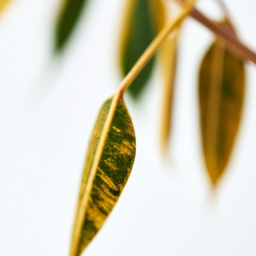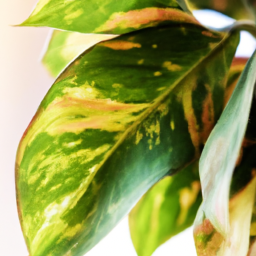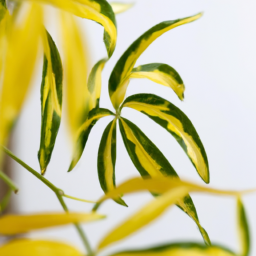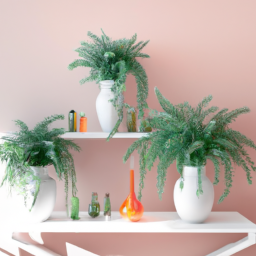
Have you ever noticed that your indoor plants’ leaves turn yellow? It can be quite alarming to see your once vibrant and green plants suddenly lose their color. But fear not, because in this blog post, we will explore the reasons behind why indoor plants’ leaves turn yellow and provide you with some helpful tips on how to prevent and treat this common issue. So, if you’re curious about what might be causing your indoor plants to lose their luster, keep reading to find out!
Common Causes of Yellow Leaves in Indoor Plants
Indoor plants are a wonderful addition to any home or office, bringing a touch of nature indoors and providing numerous benefits for our well-being. However, it can be disheartening to see their leaves turning yellow, as it is often a sign of an underlying issue that needs to be addressed. In this guide, we will explore the common causes of yellow leaves in indoor plants and provide you with a step-by-step analysis to help you identify and resolve the problem.
Poor Watering Practices
One of the most common reasons for yellow leaves in indoor plants is improper watering. Overwatering or underwatering can both lead to leaf discoloration. When plants receive too much water, their roots become waterlogged, leading to root rot and nutrient deficiencies. On the other hand, underwatering deprives plants of the necessary moisture, causing stress and nutrient imbalances.
To determine if your plant is suffering from poor watering practices, check the soil moisture level regularly. Stick your finger about an inch deep into the soil. If it feels excessively wet or soggy, your plant may be overwatered. Conversely, if the soil feels dry and crumbly, it’s a sign of underwatering. Adjust your watering schedule accordingly, ensuring that the soil remains slightly moist but not waterlogged.
Additionally, consider the type of pot and drainage system your indoor plant has. If the pot lacks drainage holes, excess water may accumulate at the bottom, leading to root rot. Ensure that your plant’s pot has adequate drainage to prevent waterlogging.
Inadequate Lighting Conditions
Light is essential for photosynthesis, the process by which plants convert light energy into chemical energy, enabling them to grow and thrive. Insufficient light can hinder this process, causing yellowing leaves. Different plants have varying light requirements, so it’s crucial to understand the specific needs of your indoor plant.
If your plant is not receiving enough light, consider relocating it to a brighter spot in your home or office. South-facing windows typically provide the most sunlight, while east and west-facing windows offer moderate light levels. If natural light is limited, you can supplement it with artificial grow lights specifically designed for indoor plants.
On the other hand, excessive light exposure can also lead to yellow leaves. Some plants are sensitive to direct sunlight and may develop sunburn, which manifests as yellow or brown patches on their leaves. If you notice this, move your plant to a spot with filtered or indirect light.
Nutrient Deficiencies
Indoor plants rely on a balanced supply of nutrients for healthy growth. When essential nutrients are lacking, plants may exhibit yellowing leaves as a sign of nutrient deficiencies. The most common nutrient deficiencies include nitrogen, iron, and magnesium.
Nitrogen is vital for leaf development, and a deficiency can cause leaves to turn pale yellow. Iron deficiency, known as chlorosis, leads to yellowing of the leaves while the veins remain green. Magnesium deficiency, similar to iron deficiency, results in yellowing leaves with green veins.
To address nutrient deficiencies, consider fertilizing your indoor plants with a balanced fertilizer specifically formulated for houseplants. Follow the instructions on the fertilizer package, as over-fertilization can also cause harm to your plants. If you suspect a specific nutrient deficiency, you can opt for a targeted fertilizer that addresses the lacking nutrient.
In conclusion, yellow leaves in indoor plants can be attributed to poor watering practices, inadequate lighting conditions, or nutrient deficiencies. By understanding these common causes and following the step-by-step analysis provided, you can effectively diagnose and address the issue. Remember to observe your plants closely, make necessary adjustments, and provide them with the care they need to thrive. With proper attention and care, your indoor plants will once again boast vibrant, green foliage that enhances the beauty of your living or working space.

How to Prevent and Treat Yellow Leaves in Indoor Plants
Indoor plants can bring life and beauty to any space, but it can be disheartening to see their leaves turn yellow. Yellowing leaves are often a sign of a problem, but don’t worry! In this guide, we will explore the common causes of yellow leaves in indoor plants and provide you with step-by-step solutions to prevent and treat this issue.
Identifying the Causes
Before we dive into the prevention and treatment methods, it’s crucial to understand why your indoor plants’ leaves may be turning yellow. By identifying the root cause, you can effectively address the issue and restore your plants’ health. Here are some common reasons:
1. Overwatering: One of the leading causes of yellow leaves in indoor plants is overwatering. When plants receive excessive amounts of water, their roots become waterlogged, leading to poor oxygen circulation and root rot. This lack of oxygen and root damage can result in yellowing leaves.
2. Underwatering: On the other hand, underwatering can also cause leaves to turn yellow. When plants don’t receive enough water, their roots dry out, and the plant becomes stressed. This stress manifests as yellowing leaves as the plant struggles to maintain its health.
3. Nutrient Deficiency: Indoor plants require a balanced diet of essential nutrients to thrive. When they lack vital nutrients like nitrogen, iron, or magnesium, their leaves can turn yellow. Nutrient deficiencies can occur due to poor soil quality or inadequate fertilization.
4. Light Issues: Light is vital for the process of photosynthesis, which is crucial for plant health. Insufficient light or exposure to direct sunlight can both cause yellowing leaves. Different plant species have varying light requirements, so it’s essential to provide your indoor plants with the appropriate amount and type of light.
Prevention and Treatment Methods
Now that we’ve identified the common causes of yellow leaves, let’s explore the preventive measures and treatments you can implement:
1. Watering: Proper watering is key to maintaining healthy indoor plants. Ensure that you water your plants when the top inch of soil feels dry. Avoid overwatering by allowing the excess water to drain out from the bottom of the pot. Additionally, make sure your pots have drainage holes to prevent water from accumulating.
2. Soil and Fertilization: Use high-quality, well-draining soil that allows proper root aeration. Regularly fertilize your plants with a balanced indoor plant fertilizer to provide them with essential nutrients. Follow the instructions on the fertilizer packaging to avoid over or under-fertilization, which can lead to yellowing leaves.
3. Light Management: Understand the light requirements of your specific indoor plants and place them accordingly. If your plants require bright, indirect light, ensure they are positioned near a window or invest in artificial grow lights. On the other hand, if your plants need low light, keep them away from direct sunlight exposure.
4. Pest Control: Pests like spider mites, aphids, or mealybugs can cause stress to indoor plants, leading to yellowing leaves. Regularly inspect your plants for any signs of infestation and take appropriate measures to control and eliminate pests. This can include using organic insecticidal soap or introducing natural predators like ladybugs.
5. Pruning: Regular pruning helps maintain the health and shape of your indoor plants. Remove any yellow or dead leaves to prevent the plant from wasting energy on them. Pruning also encourages new growth and improves air circulation around the plant, reducing the risk of diseases.
6. Humidity: Some indoor plants thrive in humid environments. If your plant requires higher humidity levels, consider using a humidifier or placing a tray filled with water near the plant. This helps create a microclimate that mimics their natural habitat, preventing leaf yellowing.
By following these preventive measures and treatment methods, you can effectively prevent and treat yellow leaves in your indoor plants. Remember to observe your plants closely, as different species may have specific needs. With proper care, your indoor plants will thrive, adding beauty and freshness to your living space.

Tips for Reviving Indoor Plants with Yellow Leaves
Indoor plants can add beauty and freshness to any living space. However, it can be disheartening to see their leaves turning yellow. Yellowing leaves are often a sign of underlying issues that need to be addressed promptly to revive your plants. In this guide, we will explore the common causes of yellow leaves in indoor plants and provide you with practical tips to bring them back to their vibrant, green glory.
Identifying the Cause
Before you can effectively revive your indoor plants, it’s crucial to identify the cause of the yellowing leaves. Several factors can contribute to this issue, including:
1. Overwatering: One of the most common causes of yellow leaves is overwatering. When the roots of your plants are constantly soaked, they can’t access the necessary oxygen, leading to root rot and yellowing leaves.
2. Underwatering: On the flip side, underwatering can also cause leaves to turn yellow. When plants don’t receive enough water, they become dehydrated, leading to nutrient deficiencies and leaf discoloration.
3. Nutrient Deficiencies: Indoor plants require a balanced diet of essential nutrients to thrive. If they lack certain nutrients like nitrogen, iron, or magnesium, their leaves may turn yellow as a result.
4. Light Levels: Insufficient or excessive light can also cause leaves to yellow. Each plant has specific light requirements, and if they are not met, it can impact their overall health and leaf color.
5. Temperature Stress: Extreme temperature fluctuations or exposure to drafts can stress indoor plants, leading to yellowing leaves. It’s essential to provide a stable and suitable environment for your plants.
Reviving Your Indoor Plants
Now that we have identified the potential causes, let’s delve into some effective tips to revive your indoor plants with yellow leaves:
1. Adjust Your Watering Routine: Evaluate your watering habits and ensure you are neither overwatering nor underwatering your plants. Check the moisture level of the soil before watering and adjust accordingly. Remember, it’s better to underwater than to overwater.
2. Improve Drainage: To prevent overwatering and root rot, make sure your plant’s pots have proper drainage holes. If your plant is in a pot without drainage, consider repotting it into a container that allows excess water to escape.
3. Provide Adequate Light: Research the light requirements of your specific indoor plants and place them in suitable locations accordingly. If your plant requires bright, indirect light, ensure it is receiving enough light to thrive. On the other hand, if it needs low light conditions, avoid exposing it to direct sunlight.
4. Check Nutrient Levels: Assess if your plant is experiencing nutrient deficiencies by examining the symptoms and conducting a soil test. If necessary, use a balanced fertilizer or specific nutrient supplements to address any deficiencies and promote healthy leaf growth.
5. Maintain Consistent Temperature: Avoid exposing your indoor plants to extreme temperature fluctuations or drafts. Keep them away from cold windows during winter and ensure they are not placed near heating vents or air conditioning units. Maintaining a stable temperature will help prevent stress and yellowing leaves.
6. Prune Yellow Leaves: Regularly inspect your plants and prune any yellow or dead leaves. This will not only improve the appearance of your plants but also redirect energy towards healthier foliage.
7. Monitor Humidity: Some indoor plants thrive in high humidity environments. If your plant requires higher humidity levels, consider using a humidifier or placing a tray of water near the plant to increase moisture in the air.
8. Be Patient: Reviving indoor plants takes time and patience. Don’t expect immediate results. Monitor your plants closely, make necessary adjustments, and give them the care they need. With time, you should start to see improvements in leaf color and overall plant health.
By following these tips and taking proactive measures, you can revive your indoor plants with yellow leaves and create a thriving green oasis within your home. Remember, each plant is unique, so it’s essential to understand their specific needs and provide them with the care they require. Happy gardening!
Essential Points
Indoor plants can be a delightful addition to any home, bringing a touch of nature indoors. However, it can be disheartening to see their leaves turning yellow. Don’t worry, though, because this is a common issue that can be resolved with a little care and attention.
One of the most common reasons for yellowing leaves is overwatering. Plants need a balance of moisture to thrive, and excessive watering can lead to root rot, causing the leaves to turn yellow. To avoid this, it’s important to check the moisture level of the soil before watering and ensure proper drainage. Another possible cause is insufficient light. Just like humans, plants need sunlight to produce energy through photosynthesis. If your indoor plants are not receiving enough light, their leaves may turn yellow. Consider moving them to a brighter spot or using artificial grow lights to provide the necessary light intensity.
Q&A Corner:
Q1: Why are the leaves of my indoor plants turning yellow?
A1: Yellowing leaves on indoor plants can be caused by various factors. One common reason is overwatering. When plants receive too much water, their roots may become waterlogged, leading to root rot and yellowing leaves. Another possible cause is underwatering, where the plant doesn’t receive enough water and the leaves start to wilt and turn yellow. Additionally, nutrient deficiencies, inadequate lighting, pests, or even natural aging can also contribute to yellowing leaves.
Q2: How can I determine if my indoor plant is being overwatered or underwatered?
A2: To determine if your indoor plant is being overwatered, check the moisture level of the soil. Stick your finger about an inch deep into the soil; if it feels excessively wet or muddy, it’s a sign of overwatering. On the other hand, if the soil feels dry and crumbly, your plant may be underwatered. Another clue is the weight of the pot – an overwatered plant will feel heavier due to waterlogged soil, while an underwatered plant will be lighter.
Q3: How can I fix yellowing leaves on my indoor plants?
A3: The first step in addressing yellowing leaves is to identify the underlying cause. If overwatering is the issue, allow the soil to dry out before watering again. Ensure that your plant’s pot has proper drainage to prevent water from accumulating. If underwatering is the problem, increase the frequency of watering, but avoid overdoing it. For nutrient deficiencies, consider using a balanced fertilizer or adjusting the pH level of the soil. Adequate lighting and regular pest inspections are also essential for maintaining healthy indoor plants.
Q4: Should I remove the yellow leaves from my indoor plants?
A4: Yes, it’s generally recommended to remove yellow leaves from indoor plants. Yellow leaves are often a sign of a problem, and by removing them, you can redirect the plant’s energy towards healthier foliage. Use clean pruning shears or scissors to carefully trim off the yellow leaves at the base, close to the stem. Be cautious not to damage the healthy parts of the plant while doing so.
Q5: Can yellow leaves be a sign of a more serious problem with my indoor plants?
A5: While yellow leaves are commonly caused by minor issues like overwatering or nutrient deficiencies, they can occasionally indicate more serious problems. For example, if the yellowing is accompanied by dark spots, mushy stems, or a foul odor, it could be a sign of a fungal or bacterial disease. In such cases, it’s advisable to isolate the affected plant, remove the diseased parts, and consider using appropriate treatments or seeking advice from a plant expert to prevent further spread.
Dr. Olivia Green is a botanist with over two decades of experience in indoor plant cultivation. She holds a Ph.D. in Plant Biology and has dedicated her career to researching plant behavior in controlled environments. Dr. Green is passionate about helping plant enthusiasts master the art of indoor gardening through her extensive knowledge and practical insights.


